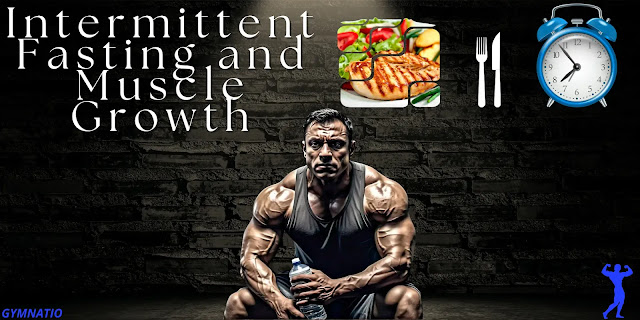Intermittent fasting (IF) has surged in popularity as a powerful tool for fat
loss, but can it also support muscle growth? Many fitness enthusiasts worry
that fasting might sabotage their gains, but
emerging research
suggests otherwise. When paired with strategic nutrition and training,
intermittent fasting can *enhance* muscle growth while improving metabolic
health. This comprehensive guide breaks down how to use IF to build lean
muscle, optimize recovery, and avoid common pitfalls.
Table of Contents.
Understanding Intermittent Fasting
Intermittent fasting involves cycling between periods of eating and fasting. Popular methods include:-*16/8 Method*: Fast for 16 hours, eat within an 8-hour window (e.g., 12 PM–8 PM).
-*5:2 Diet*: Eat normally for 5 days, restrict calories to 500–600 on 2 non-consecutive days.
-*Eat-Stop-Eat*: 24-hour fasts once or twice weekly.
Why It Works?
Fasting triggers autophagy (cellular cleanup), boosts growth hormone (by up to
1,300% in 24-hour fasts), and improves insulin sensitivity—all critical for
muscle preservation and growth.
*Myth*: “Fasting burns muscle for energy.”
*Reality*: Short-term fasting (<24 hours) primarily uses stored glycogen and fat. Muscle breakdown becomes significant only after prolonged fasting (48+ hours). Studies show IF preserves lean mass when protein intake is adequate.
*Key Science**:- Fasting increases **norepinephrine**, enhancing fat oxidation.- Post-fasting meals spike **mTOR activation**, driving protein synthesis.
Can You Build Muscle While Fasting? Debunking Myths
*Reality*: Short-term fasting (<24 hours) primarily uses stored glycogen and fat. Muscle breakdown becomes significant only after prolonged fasting (48+ hours). Studies show IF preserves lean mass when protein intake is adequate.
*Key Science**:- Fasting increases **norepinephrine**, enhancing fat oxidation.- Post-fasting meals spike **mTOR activation**, driving protein synthesis.
6 Essential Tips to Build Muscle with Intermittent Fasting
1. Prioritize Protein Timing and Quantity
-*Daily Goal*: Aim for **1.2–2.2g of protein per kg of body weight** (e.g., 90–165g for a 75kg lifter).-*Post-Workout*: Consume 20–40g of fast-absorbing protein (whey isolate, egg whites) within 1–2 hours of training.
-*Meal Spacing*: Distribute protein evenly across meals (e.g., 30–40g per meal).
2. Train in a Fed or Fasted State?
-*Fasted Training*: Enhances fat burning but may reduce intensity. Use BCAAs (10g pre-workout) to prevent catabolism.-*Fed Training*: Ideal for heavy lifting. Schedule workouts 2–3 hours after a protein-rich meal.
3. Optimize Your Eating Window
-*For Bulking*: Use an 8–10-hour window to hit calorie surplus goals (e.g., 3,000+ calories).-*For Cutting*: Tighten the window to 6–8 hours to control hunger and maintain a deficit.
4. Choose Nutrient-Dense Foods
Focus on muscle-building foods during your eating window:-*Proteins*: Chicken, salmon, Greek yogurt, tofu.
-*Carbs*: Sweet potatoes, oats, quinoa.
-*Fats*: Avocado, nuts, olive oil.
Sample Meal Plan (8-Hour Window):
-*12 PM*: Grilled
chicken + quinoa + broccoli.
-*3 PM*: Protein shake + banana + almond butter.
-*6 PM*: Salmon + jasmine rice + asparagus.
-*8 PM*: Cottage cheese + berries.
-*3 PM*: Protein shake + banana + almond butter.
-*6 PM*: Salmon + jasmine rice + asparagus.
-*8 PM*: Cottage cheese + berries.
5. Track Progress and Adjust
-*Weigh Weekly*: Aim for 0.25–0.5kg weight gain/month (bulking) or 0.5–1kg loss/month (cutting).-*Strength Metrics*: Track lifts (e.g., bench press, squats) to ensure progressive overload.
6. Supplement Strategically
-*Creatine*: 5g/day boosts strength and muscle volume.
-*Electrolytes*: Sodium, potassium, and magnesium prevent cramps during fasts.
-*Vitamin D*: Supports testosterone and recovery.
-*Electrolytes*: Sodium, potassium, and magnesium prevent cramps during fasts.
-*Vitamin D*: Supports testosterone and recovery.
Common Mistakes to Avoid
-*Underrating Calories*: Fasting makes it easy to undereat. Use apps like MyFitnessPal to track intake.-*Skipping Post-Workout Nutrition*: Delay meals post-training, and you’ll miss the anabolic window.
-*Neglecting Sleep*: Poor sleep raises cortisol, hindering muscle growth. Aim for 7–9 hours nightly.
The Bottom Line
Intermittent fasting and muscle growth aren’t mutually exclusive. By timing protein intake, training strategically, and maintaining a calorie surplus (or deficit), you can build a lean, muscular physique while enjoying fasting’s metabolic benefits.Take Action Today
. Start with a 12-hour fast and gradually increase to 16 hours.
. Plan protein-rich meals around workouts.
. Monitor strength and body composition monthly.
"Discover how to build muscle with intermittent fasting! Science-backed tips, meal plans, and training strategies to maximize gains without losing lean mass."
. Plan protein-rich meals around workouts.
. Monitor strength and body composition monthly.
"Discover how to build muscle with intermittent fasting! Science-backed tips, meal plans, and training strategies to maximize gains without losing lean mass."


.webp)
%20(1).webp)